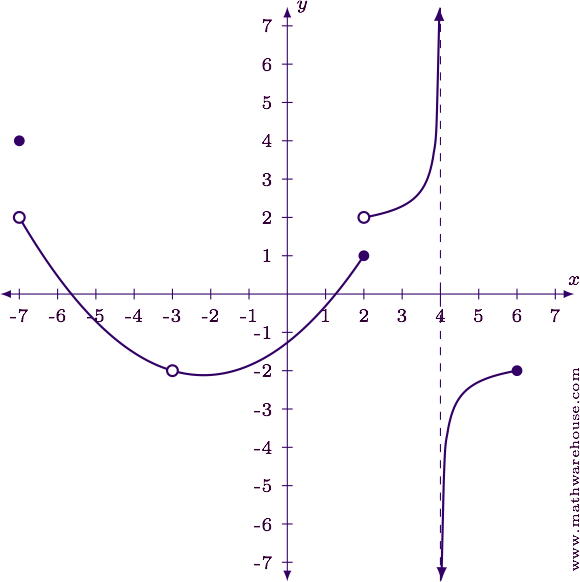How To Find Discontinuity Of A Function
Quick Overview
- On graphs, the open and airtight circles, or vertical asymptotes drawn as dashed lines help united states place discontinuities.
- As before, graphs and tables allow u.s. to estimate at best.
- When working with formulas, getting zero in the denominator indicates a point of aperture.
- When working with piecewise-defined functions, cheque for discontinuities at the transition points where 1 piece ends and the next begins.
Examples
Case ane
Using the graph shown beneath, place and classify each point of discontinuity.
 Step 1
Step 1
The table below lists the location ($$ten$$-value) of each discontinuity, and the type of discontinuity.
$$ \brainstorm{array}{c|l} {10} & {\mbox{Type}}\\ \hline -seven & \mbox{Mixed}\\ -iii & \mbox{Removable}\\ ii & \mbox{Jump}\\ four & \mbox{Space}\\ half-dozen & \mbox{Endpoint} \terminate{assortment} $$
Note that the discontinuity at $$x=-7$$ is both removable (the part value is different from the ane-sided limit value) and an endpoint (since the graph is not defined to the left of $$ten=-7$$).
Instance ii
Using the tables below, what type of discontinuity seems to exist at $$10 = 5$$?
$$ \begin{array}{c|lcc|fifty} {x} & {f(x)}\\ \hline 4.9 & 8.15\\ 4.99 & eight.015\\ iv.999 & 8.0015\\ iv.9999 & 8.00015\\ iv.99999 & 8.000015\\ \finish{array} $$
$$ \begin{array}{c|lcc|50} {x} & {f(ten)}\\ \hline 5.1 & 2.4\\ v.01 & 2.43\\ 5.001 & 2.403\\ v.0001& 2.4003\\ 5.00001 & 2.40003 \end{assortment} $$
Stride 1
Examine the 1-sided limits.
The table on the left tells u.s. $$\lim\limits_{x\to5^-}f(x) \approx 8$$
The table on the right tells us $$\lim\limits_{10\to5^+}f(x) \approx two.4$$
Answer
The tables pb u.s. to believe the i-sided limits are different, so we conclude the function likely has a jump discontinuity at $$ten = 5$$.
Example 3
Is the role below continuous at its transition point? If not, identify the blazon of discontinuity occurring there.
$$ f(x) = \left\{% \begin{assortment}{ll} x^two, & x\leq one\\ x+three, & x > one \end{array} \right. $$
Step i
Identify the transition point(s).
The transition betoken is at $$x = 1$$ since this is where the part transitions from one formula to the next.
Step 2
Decide the left-hand limit at the transition point.
$$ \displaystyle\lim_{x\to one^-} f(x) = \displaystyle\lim_{10\to ane^-} x^2 = ane^two = 1 $$
Step 3
Determine the right-paw limit at the transition point.
$$ \displaystyle\lim_{x\to i^+} f(10) = \displaystyle\lim_{ten\to 1^+} (ten+ iii) = one + iii = four $$
Answer
Since the one-sided limits are different, the role has a jump aperture at $$x = i$$.
Example iv
Is the part below continuous at x = four? If not, identify the type of discontinuity occurring there.
$$ f(ten) = \left\{% \brainstorm{array}{ll} \sqrt x, & 0\leq 10 < iv\\ 5,& x = 4\\ 6 - 10, & x > 4 \end{array} \correct. $$
Step one
Examine the left-paw limit.
$$ \displaystyle\lim_{ten\to 4^-} f(x) = \displaystyle\lim_{x\to 4^-} \sqrt x = \sqrt{four} = two $$
Stride 2
Examine the right-hand limit.
$$ \displaystyle\lim_{x\to four^+} f(x) = \displaystyle\lim_{x\to iv^+} (6-10) = 6 -4 = 2 $$
Step 3
Decide the office value.
$$ f(4) = v $$
Answer
The limit exists, and the part exists, but they have different values. The part has a removable aperture at $$x = 4$$.
Example 5
Without graphing, decide the type of discontinuity the function below has at $$ten = 3$$.
$$ f(x) = \frac{x^2 + 2x - 15}{10^two-2x-iii} $$
Footstep 1
Evaluate $$f(3)$$
$$ f(\blueish three) = \frac{(\blue{3})^ii + 2(\blue{3}) - 15}{(\blue{three})^2-2(\blueish{3})-3} = \frac{9 + 6 - 15}{9-6-three} = \frac 0 0 $$
The function is undefined at $$x = 3$$, so there is a discontinuity at this point. To determine the type, we will need to evaluate the limit as $$x$$ approaches three.
Pace 2
Since the function has a $$\frac 0 0$$ form at $$x = 3$$, nosotros need to notice and dissever out the common factors in the numerator and denominator.
$$ \frac{x^two + 2x - 15}{x^2-2x-3} = \frac{(x+v)\blue{(x-3)}}{\blue{(x-3)}(x+1)} = \frac{x+5}{x+1} $$
Step 3
Evaluate the limit of the simpler function as $$x$$ approaches 3.
$$ \displaystyle\lim_{\blue{x\to3}} \frac{x+5}{10+1} = \frac{\blue 3 + 5}{\blue 3 + 1} = \frac 8 four = 2 $$
Answer
Since the limit exists, but the function value does non, we know the function has is a removable discontinuity at $$x = 3$$.
Example 6
Without graphing, determine the blazon of aperture the role below has at $$x = -1$$.
$$ f(x) = \frac{x^two + 2x - 15}{x^2-2x-three} $$
Footstep one
Evaluate $$f(-1)$$
$$ f(\blue{-1}) = \frac{(\blue{-1})^2 + 2(\blue{-1}) - 15}{(\blue{-ane})^two-2(\blueish{-1})-3} = \frac{ane - 2 - fifteen}{1+two-3} = \frac{-16} 0 $$
Since we have segmentation by zero, the function doesn't exist at $$10 = -1$$. But, the $$\frac north 0$$ form tells us the role is becoming infinitely large as $$x$$ approaches -1.
Note: In club to make up one's mind if the limit is space, we would need to know which management the function is going equally $$10$$ approached -i. Only for the purposes of classifying the aperture, information technology'due south plenty to know the function becomes infinitely large.
Answer
The office has an infinite discontinuity at $$10 = -one$$.
Go along to Problems

Mistake : Please Click on "Not a robot", then effort downloading over again.
Source: https://www.mathwarehouse.com/calculus/continuity/how-to-classify-discontinuities.php
Posted by: boddieyoubecient.blogspot.com


0 Response to "How To Find Discontinuity Of A Function"
Post a Comment